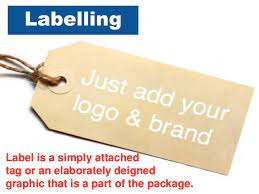
Labelling is the display of label in a product. A label contains information about a product on its container, packaging, or the product itself. It also has warnings in it. For e.g. in some products, it is written that the products contain traces of nuts and shouldn’t be consumed by a person who’s allergic to nuts. The type and extent of information that must be imparted by a label are governed by the relevant safety and shipping laws.
Labeling is also an important part of the brand of the product and the company. It helps the product stand out in the market, and identifies it as a part of a particular brand. This is important in the era of high and intense competition.
Labels serve to capture the attention of shoppers. The use of catchy words may cause strolling customers to stop and evaluate the product. The label is likely to be the first thing new customers see and thus offer their first impression of the product.
Objectives of labelling
Labels are Descriptive
A label is a carrier of information about the product. The attached label provides customers with information to aid their purchase decision or help improve the experience of using the product. Labels can include:
- Care and use of the product
- Recipes or suggestions
- Ingredients or nutritional information
- Product guarantees
- Manufacturer name and address
- Weight statements
- Sell by date and expiration dates
- Warnings
Symbols Used in Labels
Many types of symbols for package labeling are nationally and internationally standardized. For consumer packaging, symbols exist for product certifications, trademarks, and proof of purchase. Some requirements and symbols exist to communicate aspects of consumer use and safety. For example, the estimated sign notes conformance to EU weights and measures accuracy regulations. Examples of environmental and recycling symbols include the recycling symbol, the resin identification code, and the “green dot.”
Labeling Laws
In some countries, many products, including food and pharmaceuticals, are required by law to contain certain labels such as ingredients, nutritional information, or usage warning information (FDA). For example, a law label is a legally required tag or label on new items describing the fabric and filling regulating the United States mattress, upholstery, and stuffed article industry. The purpose of the law label is to inform the consumer of the hidden contents, or “filling materials” inside bedding & furniture products. Laws requiring these tags were passed in the United States to inform consumers as to whether the stuffed article they were buying contained new or recycled materials. The recycling logo needed to be displayed on the label. The Fair Packaging and Labeling Act (FPLA) is a law that applies to labels on many consumer products that states the products identity, the company that manufactures it, and the net quantity of contents.
Importance of Labelling
Labelling is an important part of the marketing of a product. Labelling is essential as it helps to grab the attention of a customer It can be combined with packaging and can be used by marketers to encourage potential buyers to purchase the product. Packaging is also used for convenience and information transmission. Packages and labels communicate how to use, transport, recycle or dispose of the package or product.
Labelling is also used to exaggerate the product. Also, it is used for identification. This kind of labeling helps a viewer to differentiate the product from the rest in the shelves of the market. A person can find out about the ingredients of a product. This helps to spread awareness among the customers about the item they are consuming and labeling also helps to mention ingredients.
Labeling is another very important factor in a product. It should show the correct information about the product. This is all the more important in products such as pharmaceuticals. Labeling should also contain information relating to whether the product has harmful chemicals, especially if it is a product that is meant for children.
Important functions of labeling:
(i) Describe the Product and Specify its Contents:
A label provides complete information regarding the product. It mainly includes ingredients of the product, its usage, and caution in use, cares to be taken while using it, date of manufacturing, batch number, etc.
(ii) Identification of the Product or Brand:
It is easier to identify a particular product among many with the help of labeling. For example, you as a consumer want to select CINTHOL SOAP. The task of finding the desired soap from a heap of various branded soaps becomes easier with the help of labeling.
(iii) Grading of Product:
When a product has different qualities, labeling helps to find out which pack contains what type of quality. For example, Hindustan Unilever Ltd., manufactures three types of tea and to differentiate the each type of tea, the company uses Green, Red and Yellow coloured labels.
(iv) Help in Promotion of Products:
The fourth function of labeling is to promote sales. Sometimes a consumer gets encouraged to buy a product simply due to attractive label. Nowadays labeling is used as an effective sales promoting tool.
(v) Providing information required by Law:
Another important function performed by labeling is to provide statutory warning required by law. To put ‘smoking is injurious to health’ on the package of cigarette and ‘Chewing Tobacco is Injurious to Health’ on the package of Pan Masala are the examples of statutory warning? Similarly, in case of hazardous or poisonous products, appropriate statutory warning need to be put on the label.







